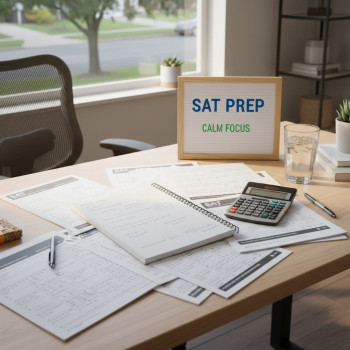Introduction: You Can Prepare—Even on a Shoestring
Let’s start with the one truth that matters most: your financial situation doesn’t define your potential. With the Digital SAT, smart planning and the right free or low-cost resources can get you far. This guide is written for students who want practical, everyday ways to prep without breaking the bank. You’ll find concrete steps, sample schedules, comparisons, and realistic trade-offs—plus a few ideas for when personalized help could make the difference.
Why the Digital SAT Is Manageable on a Budget
The Digital SAT is timed and structured, but it’s also highly practice-able. Unlike a subject that requires specialized equipment or labs, SAT skills—reading, reasoning, math fluency, and digital test navigation—can be sharpened with practice tests, short daily drills, and smart review. Best of all, many high-quality resources are free or low-cost. Pair those with community supports like school counselors or library programs, and you’re already building a strong foundation.
Know Your Options: Fee Waivers and Official Free Materials
Before spending money, check the formal supports. College Board provides fee waivers and official free practice that meaningfully reduce cost and stress.
Fee Waivers: Who Should Ask and How
If you’re low-income, a ward of the state, in foster care, eligible for free or reduced-price lunch, or partake in certain federal or state aid programs, you may qualify for SAT fee waivers. Fee waivers can cover test fees (often two free SAT administrations), free score reports to colleges, and other application-related benefits. If you’re not sure, speak with your school counselor or follow your school’s guidance for requesting a waiver. There’s also a self-identification process you can use in place of a counselor code.
Official Free Practice—Use It First
College Board offers official practice materials designed for the Digital SAT. These materials mirror the test’s format and scoring and are the most direct way to know how the real exam feels. Start there: a few scored practice tests and targeted drills will show where to invest your time.
Build a Budget-Friendly Study Plan
A plan is your best cost-saving tool. Don’t spend money on scattered apps or glossy books until you know exactly what you need to improve. Follow the steps below to create a focused plan that fits your life and your wallet.
Step 1 — Baseline: Take an Official Practice Test
- Do one timed official Digital SAT practice test under realistic conditions. Use it to identify strengths, weaknesses, and pacing issues.
- Score it honestly—don’t get stuck in analysis paralysis. The goal is diagnosis, not perfection.
Step 2 — Prioritize Weaknesses with a Pareto Mindset
Not all gaps endanger your score equally. Use the 80/20 rule: focus on the 20% of skills or question types that cost you 80% of missed points. For many students that means numeracy basics, command of evidence, sentence structure in context, or pacing strategies.
Step 3 — Make a Weekly Schedule That’s Realistic
Consistency beats marathon study sessions. Here’s a simple weekly framework you can adapt based on available time.
| Time Available per Week | Focus | Example Activities |
|---|---|---|
| 1–3 hours | Targeted practice | 30-minute daily drills; one official practice section each weekend |
| 4–7 hours | Skill building + timed practice | 2 short practice sections, 2 concept sessions (algebra/grammar), 1 full practice test every 2–3 weeks |
| 8+ hours | Comprehensive prep | Weekly full practice test, focused skill weeks, review and error logs |
Step 4 — Use an Error Log
Keep a one-page error log for each practice test: section, question number, error type (pacing, careless, concept), what you’ll do differently. This small habit prevents repeated, costly mistakes.
Free and Low-Cost Resources That Deliver
Here’s where to invest your time instead of money. These resources give the highest return at little or no cost.
Official College Board Materials
- Full-length Digital SAT practice tests—start with these so your preparation mirrors the exam.
- Question-level explanations and sample responses—use them to learn how graders think and to model structure for writing tasks.
Khan Academy and Other Community Resources
Khan Academy offers free, personalized SAT practice built from official materials. It creates practice playlists based on diagnostic results. Local libraries, high school tutors, and community centers sometimes run SAT bootcamps at low cost—ask your counselor or search for community organizations that support college access.
Affordable Books and Practice Packs
If you need print, look for one reputable practice book (ideally with real practice tests) rather than buying many. Used copies and library copies are great options.
Smart Study Techniques That Save Time and Money
Saving money isn’t just about free materials—it’s about studying smarter. Here are techniques that maximize progress per hour.
Active, Short Sessions Beat Long, Passive Ones
Let every study session have a clear goal: one concept, one problem type, or one pacing strategy. For example, instead of “study math,” commit to “complete 12 algebra linear-equation items, check errors, and rewrite two sample solutions.”
Mix Practice with Review
- Practice under test-like conditions to build stamina.
- Immediately review mistakes and rewrite how you would solve the question faster or more clearly.
Use Low-Cost Peer Study Groups
Group study can be free and effective. Form a small weekly group that swaps error logs, quizzes each other, and explains tricky questions aloud. Teaching a concept to a peer is one of the fastest ways to cement it.
Prioritize High-Impact Habits
- Sleep and nutrition—they’re free and strongly linked to concentration and memory.
- Timed practice once per week to simulate test conditions.
- Pacing drills: learn digital navigation habits like flagging questions and moving efficiently between item types.
When to Invest in Tutoring (Even Modestly)
Tutoring can be expensive, but the right slices of personalized help often give disproportionate benefits—especially when targeted to a single weakness or to final test-week strategy.
High-Value Moments for Paid Help
- If you’ve plateaued despite steady practice.
- When you need help with specific content (e.g., advanced algebra or reading strategies).
- In the final month before your test to refine pacing and test-day routines.
Low-Cost Tutoring Options
Look for: community college tutors, graduate students in education or math, or tutoring stipends through school programs. A limited block of targeted sessions (for example, four 60-minute focused lessons) can be far more effective than long-term general tutoring.
Use Personalized Tutoring Efficiently
If you do pay for tutoring, make the sessions efficient: bring an error log, a list of questions, and concrete objectives for each meeting. One neat tip: record the session (with permission) so you can review explanations without paying again.
Note: If you’re exploring personalized options, Sparkl’s personalized tutoring offers 1-on-1 guidance, tailored study plans, and AI-driven insights that can make short tutoring blocks especially efficient. Consider combining free materials with targeted Sparkl sessions for maximum impact.
Money-Smart Test-Day Strategies
Test day has costs beyond registration: travel, snacks, time off work or school. Plan to reduce or eliminate these where possible.
How to Cut Test-Day Costs
- Choose a local test center to avoid travel fees.
- Bring water and snacks from home; avoid spending on-site.
- Use fee waivers to cover registrations where eligible.
- Practice with the exact devices or device settings you’ll use so you don’t need last-minute replacements.
Backup Plans That Don’t Cost Much
If technology fails or something unexpected happens, know how to contact the test center and have a quick plan for rebooking. Often the worst cost is lost time and anxiety; a calm backup plan saves both.
Examples and Mini Case Studies
Real examples illustrate what works in the wild. Below are three short scenarios students often face, and practical, low-cost responses.
Case 1 — The Busy Student with Little Time
Sofia works part-time and has two hours a day to study. She starts with one official practice test, uses Khan Academy’s personalized playlist for 30-minute daily drills, and joins a weekly 1-hour study group at her school library. Within six weeks she improves pacing and gains 60–80 points by focusing on reading strategies and timing.
Case 2 — The Student with a Key Weakness in Math
Marcus misses a lot of algebra questions. He spends three weeks on a focused algebra mini-module using free videos and practice items, buys one used practice book for extra problems, and schedules two 1-hour tutoring sessions to troubleshoot his persistent error patterns. A narrow investment yields a measurable score increase.
Case 3 — The Student Who Needs Final-Week Confidence
Jamal has done months of study but feels jittery before the test. In the final eight days he does three timed practice sections, cuts new learning in half, and focuses on sleep, nutrition, and test routines. He books one session of personalized coaching to run through timing strategies and review an error log. The result: calmer test day and a smoother pace.
Practical Budget Checklist
Keep this printable checklist to manage costs and track actions.
| Action | Cost | Why It Helps |
|---|---|---|
| Take an official practice test | Free | Baseline—shows what to focus on |
| Get fee waiver if eligible | Free | Covers test fees, score reports, and college app benefits |
| Use Khan Academy personalized practice | Free | Adaptive practice tied to official questions |
| Join a peer study group | Free | Accountability and teaching practice |
| Buy one practice book or borrow | Low | Extra problems and strategy chapters |
| Targeted tutoring (3–6 sessions) | Variable (modest) | Break through plateaus quickly |
Emotional and Practical Support: A Key Part of Prep
Prepping on a tight budget is stressful for more than financial reasons. Worry, family obligations, and schoolwork all compete for time. The strongest plan is one that also cares for your mental energy. Here are small things that help a lot:
Daily Tiny Wins
- Cross something off your error log—celebrate the progress.
- Keep one non-study hour for something you love—music, sports, or art—so burnout doesn’t steal your momentum.
Talk to People Who Can Help
School counselors, teachers, and even admissions reps can sometimes connect you to free materials, fee waivers, or local supports. Be proactive—asking for help is part of the strategy.
Final Thoughts: Your Effort Multiplied
Preparing for the Digital SAT on a limited budget is not only possible—it can teach you efficiency and resilience. When you organize study time, use official free resources, apply for fee waivers if eligible, and invest small, targeted amounts where they matter most, your preparation will be far greater than the sum of its parts.
Remember: a smart plan and steady, honest practice beat random effort. If you need a little lift, consider combining free materials with a few targeted sessions of personalized help—Sparkl’s 1-on-1 guidance, tailored study plans, and AI-driven insights are designed to make those sessions highly effective so a small investment goes further. Whatever route you take, keep your goals in view, track your errors, and make each study hour count.
Quick Takeaways
- Start with an official practice test to diagnose needs.
- Use fee waivers and official free materials before spending money.
- Study consistently in short, active sessions and keep an error log.
- Form or join low-cost study groups and lean on school resources.
- Use targeted, brief tutoring only when it addresses a specific bottleneck.
You don’t need a big budget to compete for college. With focus, a plan, and the right supports, you can maximize your Digital SAT score and keep your finances intact. Start today, stay steady, and don’t forget to celebrate incremental wins along the way—each one is evidence that you’re building toward something bigger.
Parting Encouragement
Preparation is a marathon, not a sprint. If money is tight, your most powerful tools are structure, consistency, and curiosity. Use available free resources, check in with your counselor about fee waivers, and invest time—your effort is the single most effective currency you have. You’ve got this.
















No Comments
Leave a comment Cancel